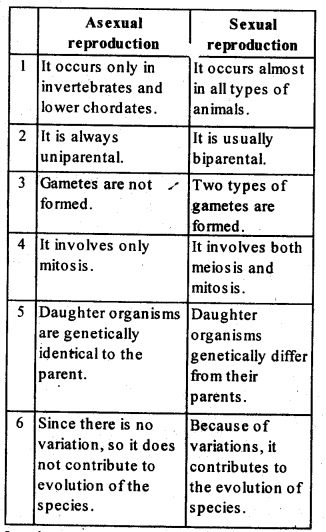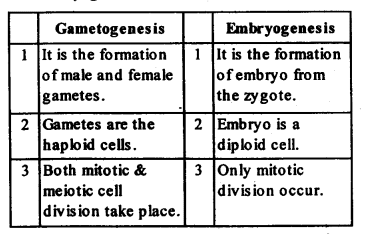Topics and Subtopics in NCERT Solutions for Class 12 Biology Chapter 1 Reproduction in Organisms:
| Section Name | Topic Name |
| 1 | Reproduction in Organisms |
| 1.1 | Asexual Reproduction |
| 1.2 | Sexual Reproduction |
| 1.3 | Summary |
QUESTIONS FROM TEXTBOOK SOLVED
1. Why is reproduction essential for organisms?
Ans: Reproduction is the ability of living organisms to produce a young one similar to itself. It ensures continuity of a species generation after generation. Reproduction introduces variation in the organisms. Useful variations are essential for adaptation and evolution. Therefore, it is essential for organisms.
2. Which Is a better mode of reproduction: sexual or asexual? Why?
Ans: Sexual reproduction is a better mode of reproduction than asexual mode because the former contributes to the evolution of the species by introducing variation in a population and occurs much more rapidly. Variation in a population occurs because of the fusion of male and female gametes (sexual reproduction) carrying different sets of chromosomes.
3. Why is the offspring formed by asexual reproduction referred to as clone?
Ans: Asexual reproduction is a type of reproduction in which a single individual is capable of producing offspring. These offspring are not only genetically and morphologically similar to one another but also similar to their parent. Clone is the term given to individuals that are genetically and morphologically similar. Thus the offspring produced by asexual reproduction are called clones.
4. Offspring formed due to sexual reproduction have better chances of survival. Why? Is this statement always true?
Ans: The offspring that are produced by sexual reproduction are not genetically identical to their parents. They exhibit variations because they receive chromosomes from two different parents. Since they show variation, they are highly adapted to the changing environment. Asexually produced organisms are genetically identical and all organism show similar adaptations. So, during any calamity, there is a possibility that the whole generation would destroy leading to extinction of species. However, this statement is not true always because of some inborn genetic disorder due to which organism have a risk in their survival, e.g., Haemophilia.
5.How does the progeny formed from asexual reproduction differ from those formed by sexual reproduction?
Ans: Production of offspring by a single parent without the formation and fiision of gametes is called asexual reproduction. It involves only mitotic cell division that gives rise the daughter cells which are genetically identical to the parent cell. Sexual reproduction is the production of offspring by two parents, male and female. It involves meiotic cell divisions producing haploid nuclei which on fusion produce offspring that are genetically different from their parents.
6. Distinguish between asexual and sexual reproduction. Why is vegetative reproduction also considered as a type of asexual reproduction?
Ans: The difference between asexual and sexual reproduction are as follows :
In plants asexual reproduction is called vegetative reproduction because vegetative plant parts like rhizome, runner, sucker, tuber, bulb all are capable of producing off springs These parts give rise to daughter individuals without the involvement of two parents.
7. What is vegetative propagation? Give two suitable examples.
Ans: Vegetative propagation in plants is a method of asexual reproduction in which the parts other than seeds are used as propagules. In fact, it is a method of propagation in those plants which have lost their capacity to produce, seeds or produce non-viable seeds (e.g., Banana, seedless Grapes, Rose, Pineapple, etc.) Among flowering plants, every part of the body, such as root, stem, leaf or bud takes part in vegetative propagation. Modified tuberous roots can be propagated vegetatively when planted in soil (e.g., sweet potato).
Underground modified stems such as rhizomes (e.g., Ginger, Eichhornia or water hyacinth, etc.), corms (e.g., Colocasia, Banana, etc.), bulbs.(e.g., Garlic, onion, etc.), etc.
8. Define:
(a)Juvenile phase
(b)Reproductive phase
(c)Senescent phase.
Ans: (a)Juvenile phase : All organisms have to reach a certain stage of growth and maturity in their life before they can reproduce sexually. That period of growth is called juvenile phase. However, this phase is known as vegetative phase in plants. This phase is of different durations in different organisms.
(b)Reproductive phase: The end of juvenile/ vegetative phase marks the beginning of reproductive phase. During this phase, the organisms produce offspring. In higher plants, this phase can be easily seen when they come to flower but in animals, the juvenile phase is followed by morphological and physiological changes prior to active reproductive behaviour. The reproductive phase is also of variable period in different organisms like some plants, flower throughout the year while others show seasonal flowering. In animals like birds lay eggs seasonally “but when in captivity (as in poultry farms) can be made to lay eggs throughout the year. Placental female mammals, undergo cyclical changes in reproductive organs during this phase.
(c) Senescent phase: It begins from the end of the reproductive phase. During this phase of life span, there is progressive deterioration in the body (like slowing of metabolism, etc.). Old age ultimately leads to death.
9. Higher organisms have resorted to sexual reproduction in spite of its complexity. Why?
Ans: Higher organisms have resorted to sexual reproduction in spite of its complexity because sexual reproduction results in multiplication and perpetuation of species and also contributes to evolution of species by introducing variation much more faster than asexual reproduction in a particular population. Sexual reproduction enables higher organisms to survive during unfavourable conditions.
10. Explain why meiosis and gametogenesis are always interlinked?
Ans: In sexual reproducing organisms, meiosis occurs during gametogenesis to reduce the diploid number of chromosomes (2n) to haploid number of chromosomes (n) in the gametes. Thus, gametes are formed as a result of meiosis so that their chromosome number.
11. Identify each part in a flowering plant and write whether it is haploid (n) or diploid (2n).
(a)Ovary ————————
(b)Anther ————————
(c)Egg ————————
(d)Pollen ————————
(e)Male gamete ————————
(f)Zygote ————————
Ans: (a)2n (b)2n (c)n (d)n (e)n (f)2n
12. Define external fertilization. Mention its disadvantages.
Ans: When fusion of the gametes takes place outside the body of the organisms, it is called external fertilization or external syngamy. The external medium like water is required for this form of fertilization. This form, is found in many aquatic animals like fishes, amphibians, majority of algae.
In this, parents release eggs and sperms in the surrounding water, then fertilization and development of offspring occur externally. Disadvantages of external fertilization:
(i)if occurs only in aquatic medium.
(ii)A chance factor is involved requiring synchronous release of gametes nearby and absence of turbulence of water.
(iii)There is no protection to young ones. They are vulnerable to a number of predators.
13. Differentiate between a zoospore and a zygote.
Ans: Zoospores are Ihe microscopic, flagellated (motile)
special asexual reproductive structures found in certain members of the kingdom fungi and simple plants like algae whereas zygote is a diploid cell formed by die fusion of male and female gametes. The zygote is usually nonflagellated.
Zoospores are the structures that give rise to new organism whereas zygote is formed after fertilization which develops into a mature organism.
14. Differentiate between gametogenesis from embryogenesis.
Ans: Differences between gametogenesis and embryogenesis are as follows :
15. Describe the post-fertilization changes in a flower.
Ans: In sexual reproduction, events that occur after the formation of zygote are called post-fertilization events. In flowering plants, the zygote is formed inside the ovule. After fertilization the sepals, petals and stamens of the flower wither and fall off. But the pistil remains attached to the plant. The zygote develops into the embryo and the ovules develop into the seed. The ovary develops into die fruit that develops.a thick wall called pericarp which is protective in – function. After dispersal, seeds germinate under favourable conditions to produce new plants.
16. What is % bisexual flower? Collect five bisexual flowers from your neighbourhood and with the help of your teacher find out their common and scientific names.
Ans: Flowers in which male and female sex organs (stamens and carpels) are borne on the same flowers are called bisexual flowers. You can observe following bisexual flowers in your kitchen and colony gardens :
(i)Brassica (sarson) – Brassica campestris
(ii)Onion – Allium cepa
(iii)Garden Pea (Edible pea) – Pisum sativum
(iv)Petunia – Petunia hybrida
(v)China rose (shoe flower) – Hibiscus rosa- sinensis.
17. Examine a few flowers of any cucurbit plant and try to identify the staminate and pistillate flowers. Do you know any other plant that bears unisexual flowers?
Ans: The male or staminate flowers of cucurbits bear bright coloured petals and a prominent group of stamens. Male plants or staminate flowers do not bear fruits. The female or pistillate flowers bear fruits. In a fertilised young pistillate flower very small fruit is visible below petals and sepals. Some unisexual plants are : Papaya, Mulberry and Date-palm.
18. Why are offspring of oviparous animals at a greater risk as compared to offspring of viviparous animals?
Ans: In oviparous animals, the development of the zygote takes place outside the body of the female parent whereas in viviparous animals, it takes place inside the body of the female. Because in oviparous animals, the fertilized eggs are laid in the open environment where they are not protected from the predators. Thus their survival rate is very less as compared to offspring of viviparous animals.




